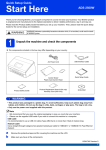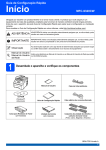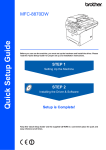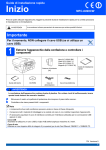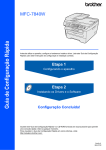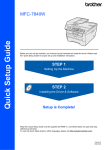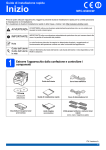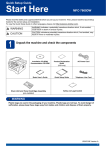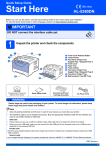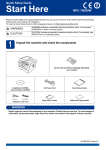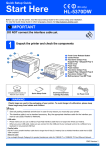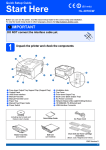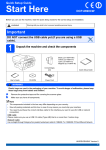Download Brother 32PFL7403D All in One Printer User Manual
Transcript
Quick Setup Guide
Start Here
MFC-8890DW
Before you can use the machine, read this Quick Setup Guide for the correct setup and installation.
To view the Quick Setup Guide in other languages, please visit http://solutions.brother.com/.
IMPORTANT
DO NOT connect the interface cable yet.
1
Unpack the machine and check the components
Drum Unit Assembly
(including Standard Toner Cartridge)
Quick Setup Guide
Telephone Line Cord
User’s Guide
CD-ROMS
(Windows®)
(Macintosh®)
Telephone Line Cord Adapter
(Australia only)
Australia and
New Zealand
Hong Kong, Malaysia
and Singapore
Philippines and Thailand
The mains plug supplied with this machine is a
grounded three pin plug.
The mains plug supplied with this machine is a
side grounded two pin plug.
AC Power Cord
Make sure that the AC socket will accept the supplied grounded pin plug. This machine must be grounded, If in doubt, call a
qualified electrician.
WARNING
Plastic bags are used in the packaging of your machine. To avoid danger of suffocation, please keep
these bags away from babies and children.
ARL/ASA/NZ Version 0
1
Note
• The components included in the box may differ depending on your country.
• Save all packing materials and the box in case for any reason you must ship your machine.
• The interface cable is not a standard accessory. Buy the appropriate interface cable for the interface you
want to use (USB, Parallel or Network).
• To ensure safe operation the supplied plug must be inserted only into a standard power outlet that is
properly grounded through the standard electrical wiring. Non grounded equipment may cause an electrical
shock hazard, and may cause excessive electrical noise radiation.
USB cable
• Please make sure you use a USB 2.0 cable (Type A/B) that is no longer than 2 metres.
• DO NOT connect the interface cable at this time. Connecting the interface cable is done during MFL-Pro
installation process.
• When you use a USB cable, make sure you connect it to the USB port of your computer and not to a USB
port on a keyboard or non-powered USB hub.
Parallel cable
DO NOT use a parallel interface cable that is longer than 2 metres. Use a shielded interface cable that is IEEE
1284-compliant.
Network cable
Use a straight-through Category5 (or greater) twisted-pair cable for 10BASE-T or 100BASE-TX Fast Ethernet
Network.
Symbols used in this guide
WARNING
WARNINGS tell you what to do to prevent possible personal injury.
CAUTION
CAUTIONS specify procedures you must follow or avoid to prevent possible
minor injuries.
IMPORTANT
IMPORTANT describe procedures you must follow or avoid to prevent possible
machine problems or machine damage, or damage to other objects.
Electrical Hazard icons alert you to a possible electrical shock.
Hot Surface icons warn you not to touch machine parts that are hot.
Note
Notes tell you how you should respond to a situation that may arise or give tips
about how the current operation works with other features.
Indicates reference to the User’s Guide, Software User’s Guide or Network
User’s Guide
Software User’s Guide User’s Guide.
Network User’s Guide
2
CAUTION
CAUTION
When you move the machine, grasp the side handholds that are under the scanner. DO NOT carry the machine
by holding it at the bottom.
Note
Keep a minimum gap around the machine as shown in the illustration.
300 mm
200 mm
500 mm
130 mm
3
2
Install the drum unit and
toner cartridge assembly
d
Gently shake it from side to side several times
to distribute the toner evenly inside the
assembly.
IMPORTANT
DO NOT connect the interface cable yet.
a
b
Remove the protective tape and film covering
the scanner glass.
e
Put the drum unit assembly into the machine
until it clicks into place.
Press the front cover release button and open
the front cover a.
1
f
c
4
Unpack the drum unit and toner cartridge
assembly.
Close the front cover of the machine.
a
3
Load paper in the paper
tray
c
Fan the stack of paper well to avoid paper jams
and misfeeds.
Pull the paper tray completely out of the
machine.
d
Put paper in the tray, and make sure that the
paper is below the maximum paper mark a.
The side to be printed on must be face down.
1
b
While pressing the blue paper-guide release
lever a, slide the paper guides to fit the paper
size you are loading in the tray. Make sure that
the guides are firmly in the slots.
IMPORTANT
Make sure the paper guides touch the sides of
the paper so it will feed correctly.
e
1
f
Put the paper tray firmly back in the machine.
Make sure that it is completely inserted into the
machine.
Unfold the support flap a to prevent paper
from sliding off the face-down output tray.
Note
For Legal or Folio size paper, press the release
button a in the bottom of the paper tray and then
pull out the back of the paper tray.
(Legal or Folio size paper are not available in
some regions.)
1
11
5
4
Release the scanner lock
c
Connect the telephone line cord. Connect one
end of the telephone line cord to the socket on
the machine marked LINE and the other end to
a modular wall socket.
Push the lever a in the direction shown to unlock the
scanner.
(The grey scanner lock lever is located at the back left
side, under the document cover b.)
2
1
IMPORTANT
5
The telephone line cord MUST be connected
to the socket on the machine marked LINE.
Connect the power cord
and telephone line
IMPORTANT
DO NOT connect the interface cable yet.
a
b
6
Make sure that the machine power switch is off.
Connect the AC power cord to the machine.
Plug the AC power cord into an AC outlet. Turn
the power switch on.
WARNING
The machine must be grounded using an
earthed plug.
Since the machine is grounded through the
power outlet, you can protect yourself from
potentially hazardous electrical conditions on
the telephone network by keeping the power
cord connected to your machine when you
connect it to a telephone line. Similarly, you
can protect yourself when you want to move
your machine by disconnecting the telephone
line first and then the power cord.
If you are sharing one telephone line with an
external telephone, connect it as shown below.
Before you connect the external telephone,
remove the protective cap a from the EXT. jack
on the machine.
1
2
Set your country (for
Australia/New Zealand
customer only)
6
Note
You must set your country so that the machine works
correctly on local telecommunication lines in each
country.
a
b
Check that the power is turned on by plugging
in the power cord and turn the power switch on.
Press
or
to choose the country
(Australia or New Zealand).
Set Country
a Australia
b New Zealand
1
Select ab or OK
(Example
for Australia)
1 Extension telephone
2 External telephone
Press OK when the LCD shows your country.
c
Note
If you are sharing one telephone line with an
external telephone answering machine, connect it
as shown below.
The LCD prompts you to make sure of the
country again.
Set Country
Australia
1.Yes
2.No
Before you connect the external telephone
answering machine, remove the protective cap a
from the EXT. jack on the machine.
Enter Number
d
If the LCD shows the correct country, press 1
to go to Step e.
—OR—
Press 2 to go back to Step b to choose the
country again.
e
After the LCD shows Accepted, the machine
will restart automatically. After the restart, the
LCD shows Please Wait.
Note
1
(Example
for Australia)
Set the receive mode to External TAD if
you have an external answering machine.
See Choose a Receive Mode on page 8. For
additional details, see Connecting an
external TAD (telephone answering device)
in Chapter 7 of the User’s Guide.
If Scanner Locked appears on the LCD,
immediately release the scanner lock and press
Stop/Exit. (See Release the scanner
lock on page 6.)
7
7
8
Choose a Receive Mode
There are four possible receive modes: Fax Only,
Fax/Tel, Manual and External TAD.
Do you want to use the telephone features of your
machine (if available) or an external telephone or
external telephone answering device connected on the
same line as the machine?
Yes
No
Are you using the voice message
function of an external telephone
answering device?
If you are having difficulty reading the LCD, try
changing the contrast setting.
a
b
c
d
Fax Only
Your machine
automatically answers
every call as a fax.
Yes
Fax/Tel
Your machine controls
the line and
automatically answers
every call. If the call is
not a fax, the phone will
ring for you to pick up
the call.
No
Yes
Manual
You control the phone
line and must answer
every call yourself.
External TAD
Your external telephone
answering device (TAD)
automatically answers
every call. Voice
messages are stored
on the external TAD.
Fax messages are
automatically printed.
d
e
Press Menu.
Press 0.
Press 1.
Press
mode.
Press OK.
or
to choose the receive
Press Stop/Exit.
For more details, see Receiving a fax in
Chapter 6 of the User’s Guide.
8
Press Menu.
Press 1.
Press 7.
Press
to increase the contrast.
—OR—
No
Do you want the machine to
answer fax and telephone calls
automatically?
a
b
c
Set the LCD contrast
(If needed)
Press
to decrease the contrast.
Press OK.
e
Press Stop/Exit.
9
Set the date and time
g
02.Date&Time
25/03/2009
The machine displays the time, and if you set up the
station ID the date and time will be added to each fax
you send.
a
b
c
d
Time:15:25
Enter & OK Key
Press Menu.
Press 0.
Press 2.
Enter the time in 24-hour format on the dial
pad, and then press OK.
(e.g. Enter 1 5, 2 5 for 3:25 P.M.)
h
Press Stop/Exit.
Enter the last two digits of the year on the dial
pad, and then press OK.
02.Date&Time
Year:2009
Enter & OK Key
(e.g. Enter 0, 9 for 2009.)
e
Enter the two digits for the month on the dial
pad, and then press OK.
02.Date&Time
XX/XX/2009
Month:03
Enter & OK Key
f
(e.g. Enter 0, 3 for March.)
Enter the two digits for the day on the dial pad,
and then press OK.
02.Date&Time
XX/03/2009
Day:25
Enter & OK Key
(e.g. Enter 2, 5.)
9
10
Enter personal
information (station ID)
You should store your name and fax number to be
printed on all fax pages that you send.
a
b
c
d
Note
• See the following chart for entering your name.
• If you need to enter a character that is on the
same key as the last character, press
move the cursor to the right.
• If you entered a letter incorrectly and want to
change it, press
or
to move the
cursor to the incorrect character, press
Clear/Back.
Press Menu.
Press 0.
Press 3.
Press
key
Enter your fax number (up to 20 digits) on the
dial pad, and then press OK.
03.Station ID
Fax:_
Enter & OK Key
e
Enter your telephone number (up to 20 digits)
on the dial pad, and then press OK. If your
telephone number and fax number are the
same, enter the same number again.
03.Station ID
Fax:XXXXXXXXXXX
Tel:_
Enter & OK Key
f
Use the dial pad to enter your name (up to 20
characters), and then press OK.
03.Station ID
Fax:XXXXXXXXXXX
Tel:XXXXXXXXXXX
Name:_
Enter & OK Key
10
to
One
time
Two
times
Three
times
Four
times
Five
times
2
A
B
C
2
A
3
D
E
F
3
D
4
G
H
I
4
G
5
J
K
L
5
J
6
M
N
O
6
M
7
P
Q
R
S
7
8
T
U
V
8
T
9
W
X
Y
Z
9
For more details, see Entering Text in the
User’s Guide.
g
Press Stop/Exit.
Note
If you make a mistake and want to start again,
press Stop/Exit and go back to step a.
11
Fax Transmission Report
Your Brother machine is equipped with a
Transmission Verification Report that can be used as
confirmation that you sent a fax. This report lists the
name or fax number of the receiving party, the date,
time, and duration of the transmission, the number of
pages transmitted, and whether or not the
transmission was successful. If you want to use the
Fax Transmission Report feature see Chapter 11
Printing Reports in the User’s Guide.
12
Set tone or pulse dialling
mode (not available in
New Zealand)
Your machine comes set for Tone dialling service. If
you have Pulse dialling service (rotary), you need to
change the dialling mode.
a
b
c
d
e
Press Menu.
The dial prefix setting will automatically dial a
predefined number before every fax number you dial.
For example: If your phone system requires a 9 to dial
an outside number this setting will automatically dial 9
for every fax you send.
a
b
c
d
Press 0.
Press 6 (For New Zealand, press 5).
Enter the prefix number (up to 5 digits) on the
dial pad, and then press OK.
Note
You can use the number 0 to 9, #, l and !. (Press
Hook to display “!”.)
You cannot use ! with any other numbers or
characters.
e
Press 4.
or
Press Menu.
If your telephone system requires a timed break
recall (hookflash), press Hook to enter the break.
Press 0.
Press
Tone).
Press OK.
13
Dial Prefix
Press Stop/Exit.
to choose Pulse (or
Press Stop/Exit.
11
14
Set Daylight Saving Time
You can set the machine to change for Daylight
Saving Time. If you choose On, it will reset the time
forward one hour and if you choose Off, it will reset
the time backward one hour.
a
b
c
d
e
f
g
12
Press Menu.
Press 1.
Press 4.
Press
or
to choose On or Off.
Press OK.
Press 1 or 2 to choose 1.Change or 2.Exit.
Press Stop/Exit.
For USB Interface Users
Macintosh®
USB
Windows®, go to page 14
Macintosh®, go to page 18
Windows®
15
Choose your connection type
For Parallel interface cable
Windows®
Macintosh®
13
Macintosh®
Windows® and Macintosh®,
go to page 30
Wireless Network
For Wireless Network
Windows®
For Windows Server® 2003/ 2008, see the Network User’s Guide on the CD-ROM.
Windows®
Windows®, go to page 24
Macintosh®, go to page 28
Wired Network
For Wired Network
Parallel
Windows®, go to page 20
USB
Windows®
For USB Interface Users
(Windows® 2000 Professional/XP/XP Professional x64 Edition/
Windows Vista®)
16
a
Before you install
Make sure that your computer is ON and you
are logged on with Administrator rights.
17
a
IMPORTANT
Install MFL-Pro Suite
Put the supplied CD-ROM into your CD-ROM
drive. If the model name screen appears,
choose your machine. If the language screen
appears, choose your language.
• DO NOT connect the USB cable yet.
• If there are any programs running, close
them.
• Make sure a USB Flash memory device is
not inserted into the machine.
• The screen may differ depending on the
operating system.
• The supplied CD-ROM includes ScanSoft™
PaperPort™ 11SE. This software supports
Windows® 2000 (SP4 or greater), XP (SP2 or
greater), XP Professional x64 Edition and
Windows Vista®. Update to the latest
Windows® Service Pack before installing
MFL-Pro Suite.
b
Turn off and unplug the machine from the AC
outlet and disconnect it from your computer, if
you already connected an interface cable.
Note
If the Brother screen does not appear
automatically, go to My Computer (Computer),
double-click the CD-ROM icon, and then
double-click Start.exe.
b
c
14
The CD-ROM main menu will appear. Click
Initial Installation.
Click Install MFL-Pro Suite.
USB
Note
f
The installation of ScanSoft™ PaperPort™
11SE will automatically start and is followed by
the installation of MFL-Pro Suite.
g
When the Brother MFL-Pro Suite Software
License Agreement window appears, click
Yes if you agree to the Software
License Agreement.
h
d
Choose Local Connection, and then click
Next. The installation continues.
If you do not want to monitor the machine
status and error notifications from your
computer, uncheck Enable Status Monitor
and then click Next.
Note
For Windows Vista®, when this screen appears,
click the check box and click Install to complete
the installation correctly.
Note
If you want to install the PS driver (Brother’s
BR-Script Driver), choose Custom Install and
then follow the on-screen instructions. When the
Select Features screen appears, check
PS Printer Driver, and then continue following
the on-screen instructions.
e
When the ScanSoft™ PaperPort™ 11SE
License Agreement window appears, click
Yes if you agree to the Software
License Agreement.
i
When this screen appears, go to the next step.
15
Macintosh®
USB
• For Windows Vista®, when the
User Account Control screen appears, click
Allow.
Windows®
• If the installation does not continue
automatically, open the main menu again by
ejecting and then reinserting the CD-ROM or
double-click the Start.exe program from the
root folder, and continue from step c to install
MFL-Pro Suite.
Windows®
USB
18
Connect the USB cable
IMPORTANT
Windows®
19
a
• DO NOT connect the machine to a USB port
on a keyboard or a non-powered USB hub.
Connect the power cord
Plug the AC power cord into an AC outlet. Turn
the power switch on.
• Connect the machine directly to your
computer.
a
The installation will continue automatically.
Remove the label covering the USB interface
connector.
The installation screens appear one after
another.
IMPORTANT
DO NOT cancel any of the screens during the
installation. It may take a few seconds for all
screens to appear.
b
b
Connect the USB cable to the USB connector
on the machine marked with the
symbol.
Then connect the cable to your computer.
16
When the On-Line Registration screen is
displayed, make your selection and follow the
on-screen instructions. Once you have
completed the registration process, close your
web browser to return to this window.
Then click Next.
USB
a
Finish and restart
Click Finish to restart your computer.
After restarting the computer, you must be
logged on with Administrator rights.
If an error message appears during the software
installation, run the Installation Diagnostics
located in Start/All Programs/Brother
/MFC-XXXX (where MFC-XXXX is your model
name).
b
If this screen appears, choose the firmware
update setting and click OK.
Note
Internet access is required for the firmware
upgrade.
Finish
The installation is now
complete.
Note
XML Paper Specification Printer Driver
The XML Paper Specification Printer Driver is the
most suitable driver when printing from the
applications that use the XML Paper Specification
documents. Please download the latest driver by
accessing the Brother Solutions Center at
http://solutions.brother.com/.
17
Macintosh®
USB
Note
Windows®
20
Windows®
USB
Macintosh®
For USB Interface Users
(Mac OS® X 10.3.9 or greater)
16
a
Before you install
b
Connect the USB cable to the USB connector
on the machine marked with the
symbol.
Then connect the cable to your computer.
Make sure your machine is connected to the
power and your Macintosh® is ON. You must
be logged on with Administrator rights.
IMPORTANT
Make sure a USB Flash memory device is not
inserted into the machine.
17
Connect the USB cable
IMPORTANT
• DO NOT connect the machine to a USB port
on a keyboard or a non-powered USB hub.
18
a
Install MFL-Pro Suite
Put the supplied CD-ROM into your CD-ROM
drive.
• Connect the machine directly to your
Macintosh®.
a
Remove the label covering the USB interface
connector.
b
Double-click Start Here OSX to install.
Note
Please see the Software User’s Guide on the
CD-ROM if you want to install the PS driver.
(Brother’s BR-Script Driver)
18
USB
c
Choose Local Connection, and then click
Next. Follow the on-screen instructions.
Macintosh®
When Presto! PageManager is installed OCR
capability is added to Brother ControlCenter2. You
can easily scan, share and organize photos and
documents using Presto! PageManager.
Double-click Presto! PageManager and follow
the on-screen instructions.
Please wait, it will take a few seconds for the
software to install. After the installation, click
Restart to finish installing the software.
d
e
f
The Brother software will search for the Brother
device. During this time the following screen
will appear.
Finish
The installation is now
complete.
Choose the machine from the list, and then
click OK.
When this screen appears, click OK.
The installation of MFL-Pro Suite is now
complete.
Go to step 19 on page 19.
19
Macintosh®
a
USB
Note
Windows®
19
Install
Presto! PageManager
Parallel
Windows®
For Parallel Interface Users
(Windows® 2000 Professional/XP/XP Professional x64 Edition)
16
a
Before you install
Make sure that your computer is ON and you
are logged on with Administrator rights.
17
a
IMPORTANT
Install MFL-Pro Suite
Put the supplied CD-ROM into your CD-ROM
drive. If the model name screen appears,
choose your machine. If the language screen
appears, choose your language.
• DO NOT connect the Parallel cable yet.
• If there are any programs running, close
them.
• Make sure a USB Flash memory device is
not inserted into the machine.
• The screen may differ depending on the
operating system.
• The supplied CD-ROM includes ScanSoft™
PaperPort™ 11SE. This software supports
Windows® 2000 (SP4 or greater), XP (SP2 or
greater) and XP Professional x64 Edition.
Update to the latest Windows® Service Pack
before installing MFL-Pro Suite.
b
Turn off and unplug the machine from the AC
outlet and disconnect it from your computer, if
you already connected an interface cable.
Note
If the Brother screen does not appear
automatically, go to My Computer (Computer),
double-click the CD-ROM icon, and then
double-click Start.exe.
b
c
20
The CD-ROM main menu will appear. Click
Initial Installation.
Click Install MFL-Pro Suite.
Parallel
Note
Windows®
g
If the installation does not continue automatically,
open the main menu again by ejecting and then
reinserting the CD-ROM or double-click the
Start.exe program from the root folder, and
continue from c to install MFL-Pro Suite.
d
When the Brother MFL-Pro Suite Software
License Agreement window appears, click
Yes if you agree to the Software
License Agreement.
Choose Local Connection, and then click
Next. The installation continues.
h
If you do not want to monitor the machine
status and error notifications from your
computer, uncheck Enable Status Monitor
and then click Next.
Note
f
When the ScanSoft™ PaperPort™ 11SE
License Agreement window appears, click
Yes if you agree to the Software
License Agreement.
i
When this screen appears, go to the next step.
The installation of ScanSoft™ PaperPort™
11SE will automatically start and is followed by
the installation of MFL-Pro Suite.
21
Windows®
e
Parallel
If you want to install the PS driver (Brother’s
BR-Script Driver), choose Custom Install and
then follow the on-screen instructions. When the
Select Features screen appears, check
PS Printer Driver, and then continue following
the on-screen instructions.
Parallel
18
Connect the Parallel
cable
Windows®
b
Do one of the following:
For Windows® 2000 Professional users,
click Next.
IMPORTANT
Connect the machine directly to your
computer.
a
Connect the Parallel interface cable to your
computer, and then connect it to the machine.
Note
If this screen appears, click OK.
19
a
Connect the power cord
Plug the AC power cord into an AC outlet. Turn
the power switch on.
The installation will continue automatically.
The installation screens appear one after
another.
22
For Windows® XP/XP Professional x64
Edition users, wait for a while since the
installation of the Brother drivers will
automatically start. The screens appear one
after another.
IMPORTANT
DO NOT cancel any of the screens during the
installation. It may take a few seconds for all
screens to appear.
c
When the On-Line Registration screen is
displayed, make your selection and follow the
on-screen instructions. Once you have
completed the registration process, close your
web browser to return to this window.
Then click Next.
Parallel
20
a
Windows®
Finish and restart
Click Finish to restart your computer.
After restarting the computer, you must be
logged on with Administrator rights.
Note
If this screen appears, choose the firmware
update setting and click OK.
Note
Internet access is required for the firmware
upgrade.
Finish
The installation is now
complete.
Note
XML Paper Specification Printer Driver
The XML Paper Specification Printer Driver is the
most suitable driver when printing from the
applications that use the XML Paper Specification
documents. Please download the latest driver by
accessing the Brother Solutions Center at
http://solutions.brother.com/.
23
Windows®
b
Parallel
If an error message appears during the software
installation, run the Installation Diagnostics
located in Start/All Programs/Brother
/MFC-XXXX LPT (where MFC-XXXX is your
model name).
Wired Network
Windows®
For Wired Network Interface Users
(Windows® 2000 Professional/XP/XP Professional x64 Edition/
Windows Vista®)
16
a
Before you install
Make sure that your computer is ON and you
are logged on with Administrator rights.
17
a
Connect the network
cable
Connect the network interface cable to the LAN
connector marked with a
symbol and then
connect it to a free port on your hub.
IMPORTANT
• If there are any programs running, close
them.
• Make sure a USB Flash memory device is
not inserted into the machine.
• The screens may differ depending on the
operating system.
• The supplied CD-ROM includes ScanSoft™
PaperPort™ 11SE. This software supports
Windows® 2000 (SP4 or greater), XP (SP2 or
greater), XP Professional x64 Edition and
Windows Vista®. Update to the latest
Windows® Service Pack before installing
MFL-Pro Suite.
IMPORTANT
Disable all personal firewall
software (other than Windows®
Firewall), anti-spyware or
antivirus applications for the
duration of the installation.
b
24
Unplug the machine from the AC outlet.
18
a
Connect the power cord
Plug the AC power cord into an AC outlet. Turn
the power switch on.
Wired Network
19
a
Windows®
Note
Install MFL-Pro Suite
• If the installation does not continue
automatically, open the main menu again by
ejecting and then reinserting the CD-ROM or
double-click the Start.exe program from the
root folder, and continue from c to install
MFL-Pro Suite.
Put the supplied CD-ROM into your CD-ROM
drive. If the model name screen appears,
choose your machine. If the language screen
appears, choose your language.
• For Windows Vista®, when the
User Account Control screen appears, click
Allow.
Note
If the Brother screen does not appear
automatically, go to My Computer (Computer),
double-click the CD-ROM icon, and then
double-click Start.exe.
b
d
Choose Wired Network Connection, and
then click Next.
The CD-ROM main menu will appear. Click
Initial Installation.
e
f
When the ScanSoft™ PaperPort™ 11SE
License Agreement window appears, click
Yes if you agree to the Software
License Agreement.
The installation of ScanSoft™ PaperPort™
11SE will automatically start and is followed by
the installation of MFL-Pro Suite.
25
Macintosh®
Click Install MFL-Pro Suite.
Wired Network
c
Windows®
Note
If you want to install the PS driver (Brother’s
BR-Script Driver), choose Custom Install and
then follow the on-screen instructions. When the
Select Features screen appears, check
PS Printer Driver, and then continue following
the on-screen instructions.
Wired Network
g
Windows®
When the Brother MFL-Pro Suite Software
License Agreement window appears, click
Yes if you agree to the Software
License Agreement.
Note
• You can find your machine’s IP address and
the node name by printing out the Network
Configuration List. See Print the Network
Configuration List on page 45.
• If your machine is not found over the network,
following screen will appear.
h
For Windows® XP SP2/XP Professional x64
Edition/ Windows Vista® users, when this
screen appears, choose Change the Firewall
port settings to enable network connection
and continue with the installation.
(Recommended) and click Next.
If you are not using the Windows ® Firewall, see
the User’s Guide for your software for
information on how to add the following
network ports.
For network scanning, add UDP port 54925.
For network PC-Fax receiving, add UDP port
54926.
If you still have trouble with your network
connection, add UDP port 137.
i
Confirm your network setting by following the
on-screen instructions.
• If the machine is not yet configured for use on
your network, the following screen appears.
Click OK and then Configure IP Address.
Enter an IP address for your machine that is
suitable for your network by following the onscreen instructions.
j
If you do not want to monitor the machine
status and error notifications from your
computer, uncheck Enable Status Monitor
and then click Next.
If the machine is configured for your network,
choose the machine from the list, and then click
Next.
k
The installation of the Brother drivers will
automatically start. The installation screens
appear one after another.
IMPORTANT
DO NOT cancel any of the screens during the
installation. It may take a few seconds for all
screens to appear.
26
Wired Network
b
Note
For Windows Vista®, when this screen appears,
click the check box and click Install to complete
the installation correctly.
l
Windows®
When the On-Line Registration screen is
displayed, make your selection and follow the
on-screen instructions. Once you have
completed the registration process, close your
web browser to return to this window.
Then click Next.
If this screen appears, choose the firmware
update setting and click OK.
Note
Internet access is required for the firmware
upgrade.
21
Install MFL-Pro Suite on
additional computers
(If needed)
If you want to use your machine with multiple
computers on the network, install MFL-Pro Suite on
each computer. Go to step 19 on page 25.
Note
Click Finish to restart your computer. After
restarting the computer, you must be logged on
with Administrator rights.
The installation is now
complete.
Note
Note
If an error message appears during the software
installation, run the Installation Diagnostics
located in Start/All Programs/Brother/
MFC-XXXX LAN (where MFC-XXXX is your
model name).
XML Paper Specification Printer Driver
The XML Paper Specification Printer Driver is the
most suitable driver when printing from the
applications that use the XML Paper Specification
documents. Please download the latest driver by
accessing the Brother Solutions Center at
http://solutions.brother.com/.
27
Macintosh®
Finish
Wired Network
a
Windows®
20
Finish and restart
The MFL-Pro Suite Software License permits
installation on up to 5 network computers. If you
want to install MFL-Pro Suite on additional
computers, you can purchase additional NL-5
(five user) license agreements from your
authorized Brother dealer or contact Brother
customer service.
Wired Network
Macintosh®
For Wired Network Interface Users
(Mac OS® X 10.3.9 or greater)
16
a
Before you install
Make sure your machine is connected to the
power and your Macintosh® is ON. You must
be logged on with Administrator rights.
18
a
Install MFL-Pro Suite
Put the supplied CD-ROM into your CD-ROM
drive.
IMPORTANT
Make sure a USB Flash memory device is not
inserted into the machine.
17
a
Connect the network
cable
b
Double-click Start Here OSX to install.
Connect the network interface cable to the LAN
connector marked with a
symbol and then
connect it to a free port on your hub.
Note
Please see the Network User’s Guide on the
CD-ROM if you want to install the PS driver.
(Brother’s BR-Script Driver)
c
Choose Wired Network Connection, and
then click Next. Follow the on-screen
instructions.
Note
Please wait, it will take a few seconds for the
software to install. After the installation, click
Restart to finish installing the software.
28
Wired Network
d
e
The Brother software will search for the Brother
device. During this time the following screen
will appear.
Macintosh®
f
When this screen appears, click OK.
The installation of MFL-Pro Suite is now
complete.
Go to step 19 on page 29.
If the machine is configured for your network,
choose the machine from the list, and then click
OK.
19
Install
Presto! PageManager
When Presto! PageManager is installed OCR
capability is added to Brother ControlCenter2. You
can easily scan, share and organize photos and
documents using Presto! PageManager.
Note
a
Double-click Presto! PageManager and follow
the on-screen instructions.
• You can find your machine’s IP address and
the node name by printing out the Network
Configuration List. See Print the Network
Configuration List on page 45.
• If your machine is not found over the network,
confirm your network setting.
• If this screen appears click OK.
Finish
The installation is now
complete.
• If you want to use the machine’s Scan key to
scan over the network, you must check the
Register your computer with the “Scan To”
function on the machine box.
• The name you enter will appear on the
machine’s LCD when you press
and
choose a scan option. (For more information,
see Network Scanning in the Software User’s
Guide on the CD-ROM.)
29
Macintosh®
If you want to use your machine with multiple
computers on the network, install MFL-Pro Suite on
each computer. Go to step 18 on page 28.
Windows®
20
Install MFL-Pro Suite on
additional computers
(If needed)
Wired Network
• Enter a name for your Macintosh® in
Display Name up to 15 characters long and
click OK. Go to f.
For Wireless Network Users
For Wireless Network Interface Users
16
Before you begin
First you must configure the wireless network settings of your machine to communicate with your network access
point (router). After the machine is configured to communicate with your access point (router) computers on your
network will have access to the machine. To use the machine from these computers, you will need to install the
drivers and software. The following steps will guide you through the configuration and installation process.
Note
• To achieve optimum results with normal everyday document printing, place the Brother machine as close
to the network access point (router) as possible with minimal obstructions. Large objects and walls between
the two devices as well as interference from other electronic devices can affect the data transfer speed of
your documents.
• Due to these factors, wireless may not be the best method of connection for all types of documents and
applications. If you are printing large files, such as multi-page documents with mixed text and large graphics,
you may want to consider choosing wired Ethernet for a faster data transfer or USB for the fastest
throughput speed.
• Although the Brother MFC-8890DW can be used in a both wired and wireless network, only one of the
connection methods can be used at a time.
• If you have previously configured the wireless settings of the machine you must reset the network (LAN)
settings before you can configure the wireless settings again.
On your machine, press Menu. Press 7.
Press 0 to choose Network Reset.
Press 1 twice for Yes to accept the change.
Note
The following instructions are for infrastructure mode.
To set up your machine in any other wireless environment you can find instructions in the Network User’s
Guide on the CD-ROM.
You can view the Network User’s Guide by following the instructions below.
1 Turn on your computer/Macintosh ®. Insert the Brother CD-ROM into your CD-ROM drive.
For Windows®:
2 Choose your model and the language. The CD-ROM main menu will appear.
3 Click Documentation, and then click HTML documents.
For Macintosh®:
2 Double-click Documentation, and then double-click your language folder.
3 Double-click top.html.
30
For Wireless Network Users
Infrastructure Mode
1
4
2
3
a
b
c
d
Access Point (router)
Wireless Network machine (your machine)
Wireless capable computer connected to the access point
Wired computer connected to the access point
Windows®
Macintosh®
Wireless Network
31
For Wireless Network Users
17
Confirm your network environment (Infrastructure Mode)
The following instructions will offer two methods for installing your Brother machine in a wireless network environment. Both
methods are for infrastructure mode, using a wireless router or access point that uses DHCP to assign IP addresses. Choose
a configuration method and proceed to the page indicated.
a
If your wireless router/access point does not support SecureEasySetup™, Wi-Fi Protected Setup or AOSS™,
write down the wireless network settings of your wireless access point/router.
IMPORTANT
If you do not know this information (Network Name, WEP key, WPA2-PSK (Pre-Shared Key), LEAP or EAPFAST) you cannot continue the wireless setup. You should see the documentation provided with your
access point or wireless router, consult the router manufacturer, or your system administrator.
Item
Example
Communication mode: (infrastructure)
Infrastructure
Network name: (SSID, ESSID)
HELLO
Authentication method:
(Open system, Shared key, WPA-PSK 1,
WPA2-PSK 1, LEAP, EAP-FAST)
WPA2-PSK
Encryption mode:
(None, WEP,TKIP, AES, CKIP)
AES
Record the current wireless network settings
Network key:
12345678
(Encryption key , WEP key 2, Passphrase)
1
WPA/WPA2-PSK is a Wi-Fi Protected Access Pre-Shared Key, which lets the Brother wireless machine associate with access points using TKIP or
AES encryption (WPA-Personal). WPA/WPA2-PSK (TKIP or AES) uses a Pre-Shared Key (PSK) that is 8 or more characters in length, up to a
maximum of 63 characters.
2
The WEP key is for 64-bit encrypted networks or 128-bit encrypted networks and can contain both numbers and letters. If you do not know this
information you should see the documentation provided with your access point or wireless router. This key is a 64-bit or 128-bit value that must be
entered in an ASCII or HEXADECIMAL format.
For example:
64-bit ASCII:
Uses 5 text characters
e.g. “Hello” (this is case sensitive)
64-bit Hexadecimal:
Uses 10 digits of hexadecimal data
e.g. “71f2234aba”
128-bit ASCII:
Uses 13 text characters
e.g.“Wirelesscomms” (this is case sensitive)
128-bit Hexadecimal:
Uses 26 digits of hexadecimal data
e.g. “71f2234ab56cd709e5412aa3ba”
Now go to
b
If your wireless router/access point supports automatic wireless (one-push) setup (SecureEasySetup™, Wi-Fi
Protected Setup or AOSS™)
Now go to
32
page 33
page 35
For Wireless Network Users
Connecting the Brother machine to the wireless network
18
a
f
or
or
to choose None for
Encryption Type? and press OK. Then
press 1 for Yes to apply your settings. Go to
step k.
No Authentication with WEP Encryption:
Choose Open System, press OK then use
to choose On, then press
The machine will search for available SSIDs. If
a list of SSIDs is displayed, use
or
to choose the SSID you wrote down in step 17
on page 32, then press OK. Go to step f.
Note
It will take several seconds to display a list of
available SSIDs.
If your access point is set to not broadcast the
SSID you will have to manually add the SSID
name. Go to step c.
c
d
Enter the SSID you wrote down in step 17 on
page 32 using the dial pad to choose each
letter or number.
Choose the appropriate key number and press
OK. Enter the WEP key you wrote down in
step 17 on page 32 using the dial pad to
choose each letter or number.
For example, to enter the letter a, press the 2
key on the dial pad once. To enter the number
3, press the 3 key on the dial pad seven times.
The letters appear in this order: lower case,
upper case and then numbers.
Press OK when you have entered all the
characters, then press 1 for Yes to apply your
settings. Go to step k.
33
Macintosh®
(For more information, see Entering Text for
Wireless Settings on page 46.)
Windows®
Press
or
to choose
Infrastructure, then press OK.
g
or
to choose WEP for the
Encryption Type? and press OK.
Go to step g.
Authentication with WEP Encryption:
Choose Shared Key and press OK.
Go to step g.
Authentication with WPA/WPA2-PSK
(TKIP or AES) Encryption:
Choose WPA/WPA2-PSK and press OK.
Go to step h.
Authentication with LEAP:
Choose LEAP, press OK. Go to step i.
Authentication with EAP-FAST/NONE,
EAP-FAST/MS-CHAPv2, EAP-FAST/GTC
(TKIP or AES Encryption):
Choose EAP-FAST/NONE,
EAP-FAST/MSCHAP (EAP-FAST/MSCHAPv2) or EAP-FAST/GTC, press OK. Go
to step j.
Wireless Network
e
Press
or
to choose <New SSID>
and press OK. Go to step d.
You can use
and
to move the
cursor left and right. For example, to enter the
letter a, press the 2 key on the dial pad once.
To enter the number 3, press the 3 key on the
dial pad seven times.
The letters appear in this order: lower case,
upper case and then numbers.
(For more information, see Entering Text for
Wireless Settings on page 46.)
Press OK when you have entered all the
characters.
Use the
,
and OK keys to choose
one of the options below: If your network is
configured for Authentication and Encryption
you must match the settings used for your
network.
No Authentication or Encryption:
Choose Open System, press OK then use
On your machine, press Menu, 7 (Network), 2
(WLAN), 2 (Setup Wizard).
Press
OK.
b
Configure the wireless
settings (Typical
Wireless Setup in
infrastructure mode)
For Wireless Network Users
h
Press
or
to choose TKIP or AES
for Encryption Type? and press OK.
Enter the WPA/WPA2-PSK password you
wrote down in step 17 on page 32 using the
dial pad to choose each letter or number.
For example, to enter the letter a, press the 2
key on the dial pad once. To enter the number
3, press the 3 key on the dial pad seven times.
The letters appear in this order: lower case,
upper case and then numbers.
(For more information, see Entering Text for
Wireless Settings on page 46.)
Press OK when you have entered all the
characters, then press 1 for Yes to apply your
settings. Go to step k.
i
Enter the user name and press OK. You can
use
or
to move the cursor. For
example, to enter the letter a, press the 2 key
on the dial pad once.
Enter the password and press OK, and then
press 1 to apply your settings. Go to step k.
(For more information, see Entering Text for
Wireless Settings on page 46.)
j
Press
or
to choose TKIP or AES
for Encryption Type? and press OK.
Enter the user name and press OK. You can
use
or
to move the cursor. For
example, to enter the letter a, press the 2 key
on the dial pad once.
k
Enter the password and press OK, and then
press 1 to apply your settings. Go to step k.
(For more information, see Entering Text for
Wireless Settings on page 46.)
Your machine will now try to connect to your
wireless network using the information you
have entered. If successful, Connected will
appear briefly on the LCD.
If your machine does not successfully connect
to your network, verify your network settings
collected in step 17 on page 32, then repeat
steps a to j to make sure you have entered the
correct information.
If your access point does not have DHCP
enabled you will need to manually configure
the IP address, subnet mask and gateway of
the machine to suit your network. See the
Network User’s Guide for details.
34
Wireless setup is now complete. A four
level indicator at the top of your
machine’s LCD will show the wireless
signal strength of your access point or
router.
To install MFL-Pro Suite, continue to
step 19.
For Windows® Users:
Now go to
page 37
For Macintosh® Users:
Now go to
page 41
For Wireless Network Users
18
a
b
c
d
Configure the wireless
settings using the
automatic wireless (onepush) method
Confirm your wireless router or access point
has the SecureEasySetup™, Wi-Fi Protected
Setup or AOSS™ symbol as shown below.
Place the Brother machine within range of a
SecureEasySetup™, Wi-Fi Protected Setup or
AOSS™ access point/router. The range may
differ depending on your environment. Refer to
the instructions provided with your access
point/router.
Push the SecureEasySetup™, Wi-Fi Protected
Setup or AOSS™ button on your wireless
router or access point.
See the user’s guide for your wireless
router/access point for instructions.
On your machine, press Menu, 7 (Network), 2
(WLAN), 3 (SES/WPS/AOSS).
Press
OK.
or
to choose On, then press
This feature will automatically detect which
mode (SecureEasySetup™, Wi-Fi Protected
Setup or AOSS™) your access point uses to
configure your machine.
Note
If your wireless access point supports the Wi-Fi
Protected Setup (PIN Method) and you want to
configure your machine using the PIN (Personal
Identification Number) Method, see Using the PIN
Method of Wi-Fi Protected Setup in the Network
User’s Guide on the CD-ROM.
If the LCD shows Setting WLAN, then
No Access Point, the machine has not
detected your router/access point on your
network with the SecureEasySetup™ mode,
the Wi-Fi Protected Setup mode or AOSS™
mode enabled. Move your machine close to the
router/access point and try starting from step c
again.
LCD messages when using
the SES/WPS/AOSS control panel menu
Setting WLAN
Searching or accessing the
access point and downloading
settings from the access point.
Connecting
SES/WPS/AOSS
Connecting to the access point.
Connection
Fail
Connection failed.
Connection
Error
A session overlap was
detected.
Connected
The machine has successfully
connected.
No Access
Point
The access point detection
failed.
Note
Wireless setup is now complete.
35
Macintosh®
If you encounter a problem during setup,
temporarily place your machine closer to the
wireless access point, and go back to step c.
Wireless Network
If the LCD shows Connected, the machine
has successfully connected to your
router/access point. You can now use your
machine with your wireless network.
If the LCD shows Setting WLAN, then
Connection Fail or Connection Error,
a session overlap or connection failure was
detected (see the table below). The machine
has detected 2 or more routers/access points
on your network that have the
SecureEasySetup™, Wi-Fi Protected Setup
mode or AOSS™ mode enabled. Make sure
that only one router/access point has the
SecureEasySetup™, Wi-Fi Protected Setup
mode or AOSS™ mode enabled and try
starting from step c again.
Windows®
e
If the LCD shows Setting WLAN,
Connecting SES (Connecting WPS or
Connecting AOSS), then
Connection Fail, the machine has not
successfully connected to your router/access
point. Try starting from step c again. If the
same message is indicated again, reset the
machine back to the default factory settings
and try again. For resetting, see Restore the
network settings to factory default on page 45.
For Wireless Network Users
Wireless setup is now complete. To
install MFL-Pro Suite, continue to
step 19.
For Windows® Users:
Now go to
page 37
For Macintosh® Users:
Now go to
page 41
36
Wireless Network
Windows®
Install the Drivers & Software
(Windows® 2000 Professional/XP/XP Professional x64 Edition/
Windows Vista®)
19
a
Before you install
MFL-Pro Suite
Make sure that your computer is ON and you
are logged on with Administrator rights.
20
a
IMPORTANT
Install MFL-Pro Suite
Put the supplied CD-ROM into your CD-ROM
drive. If the model name screen appears,
choose your machine. If the language screen
appears, choose your language.
• If there are any programs running, close
them.
• Make sure a USB Flash memory device is
not inserted into the machine.
• The screens may differ depending on the
operating system.
• The supplied CD-ROM includes ScanSoft™
PaperPort™ 11SE. This software supports
Windows® 2000 (SP4 or greater), XP (SP2 or
greater), XP Professional x64 Edition and
Windows Vista®. Update to the latest
Windows® Service Pack before installing
MFL-Pro Suite.
IMPORTANT
Note
If the Brother screen does not appear
automatically, go to My Computer (Computer),
double-click the CD-ROM icon, and then
double-click Start.exe.
b
The CD-ROM main menu will appear. Click
Initial Installation.
Disable all personal firewall
software (other than Windows®
Firewall), anti-spyware or
antivirus applications for the
duration of the installation.
c
Click Install MFL-Pro Suite.
Windows®
Macintosh®
Wireless Network
37
Wireless Network
Note
f
• If the installation does not continue
automatically, open the main menu again by
ejecting and then reinserting the CD-ROM or
double-click the Start.exe program from the
root folder, and continue from step c to install
MFL-Pro Suite.
Windows®
When the ScanSoft™ PaperPort™ 11SE
License Agreement window appears, click
Yes if you agree to the Software
License Agreement.
• For Windows Vista®, when the
User Account Control screen appears, click
Allow.
g
h
d
Choose Wireless Network Connection, and
then click Next.
i
Note
If you want to install the PS driver (Brother’s
BR-Script Driver), choose Custom Install and
then follow the on-screen instructions. When the
Select Features screen appears, check
PS Printer Driver, and then continue following
the on-screen instructions.
e
The installation of ScanSoft™ PaperPort™
11SE will automatically start and is followed by
the installation of MFL-Pro Suite.
When the Brother MFL-Pro Suite Software
License Agreement window appears, click
Yes if you agree to the Software
License Agreement.
For Windows® XP SP2/XP Professional x64
Edition/ Windows Vista® users, when this
screen appears, choose Change the Firewall
port settings to enable network connection
and continue with the installation.
(Recommended) and click Next.
Click on
Wireless settings checked and confirmed
check box, and then click Next.
If you are not using the Windows® Firewall, see
the User’s Guide for your software for
information on how to add the following
network ports.
For network scanning, add UDP port 54925.
For network PC-Fax receiving, add UDP port
54926.
If you still have trouble with your network
connection, add UDP port 137.
38
Wireless Network
j
If the machine is configured for your network,
choose the machine from the list, and then click
Next.
Note
• You can find your machine’s IP address and
the node name by printing out the Network
Configuration List. See Print the Network
Configuration List on page 45.
• If your wireless settings fail, an error message
will appear during the installation of MFL-Pro
Suite and the installation will be terminated.
Confirm your network setting by following the
on-screen instruction. If you encounter this
failure, please go to step 17 on page 32 and
setup the wireless connection again.
• If you are using WEP and the LCD displayed
‘Connected’ but your machine is not found,
make sure you entered the WEP key correctly.
The WEP key is case sensitive.
• If the machine is not yet configured for use on
your network, the following screen appears.
l
If you do not want to monitor the machine
status and error notifications from your
computer, uncheck Enable Status Monitor
and then click Next.
The installation of the Brother drivers will
automatically start. The installation screens
appear one after another.
IMPORTANT
DO NOT cancel any of the screens during the
installation. It may take a few seconds for all
screens to appear.
Note
For Windows Vista®, when this screen appears,
click the check box and click Install to complete
the installation correctly.
m
When the On-Line Registration screen is
displayed, make your selection and follow the
on-screen instructions. Once you have
completed the registration process, close your
web browser to return to this window.
Then click Next.
Macintosh®
39
Windows®
Wireless Network
Click OK and then Configure IP Address.
Enter an IP address for your machine that is
suitable for your network by following the onscreen instructions.
k
Windows®
Wireless Network
21
a
Finish and restart
Click Finish to restart your computer. After
restarting the computer, you must be logged on
with Administrator rights.
Windows®
22
Install MFL-Pro Suite on
additional computers
(If needed)
If you want to use your machine with multiple
computers on the network, install MFL-Pro Suite on
each computer. Go to step 19 on page 37.
Note
The MFL-Pro Suite Software License permits
installation on up to 5 network computers. If you
want to install MFL-Pro Suite on additional
computers, you can purchase additional NL-5
(five user) license agreements from your
authorized Brother dealer or contact Brother
customer service.
Note
If an error message appears during the software
installation, run the Installation Diagnostics
located in Start/All Programs/Brother/
MFC-XXXX LAN (where MFC-XXXX is your
model name).
b
If this screen appears, choose the firmware
update setting and click OK.
Note
Internet access is required for the firmware
upgrade.
40
Finish
The installation is now
complete.
Note
XML Paper Specification Printer Driver
The XML Paper Specification Printer Driver is the
most suitable driver when printing from the
applications that use the XML Paper Specification
documents. Please download the latest driver by
accessing the Brother Solutions Center at
http://solutions.brother.com/.
Wireless Network
Macintosh®
Install the Drivers & Software
(Mac OS® X 10.3.9 or greater)
19
a
Before you install
MFL-Pro Suite
c
Choose Wireless Network Connection, and
then click Next.
Make sure your machine is connected to the
power and your Macintosh ® is ON. You must
be logged on with Administrator rights.
IMPORTANT
Make sure a USB Flash memory device is not
inserted into the machine.
20
a
d
Install MFL-Pro Suite
Click on the
Wireless settings checked and confirmed
check box, and then click Next.
Follow the on-screen instructions.
Put the supplied CD-ROM into your CD-ROM
drive.
Note
Please wait, it will take a few seconds for the
software to install. After the installation, click
Restart to finish installing the software.
b
e
Double-click Start Here OSX to install.
41
Macintosh®
Please see the Network User’s Guide on the
CD-ROM if you want to install the PS driver.
(Brother’s BR-Script Driver)
Wireless Network
Note
If the machine is configured for your network,
choose the machine from the list, and then click
OK.
Windows®
f
The Brother software will search for the Brother
device. During this time the following screen
will appear.
Wireless Network
Note
• You can find your machine’s IP address and
the node name by printing out the Network
Configuration List. See Print the Network
Configuration List on page 45.
• If your wireless settings fail, the installation of
the MFL-Pro software will be terminated.
Confirm your network settings. If you encounter
this failure, go to step 17 on page 32 and setup
the wireless connection again.
• If this screen appears click OK.
Macintosh®
21
Install
Presto! PageManager
When Presto! PageManager is installed OCR
capability is added to Brother ControlCenter2. You
can easily scan, share and organize photos and
documents using Presto! PageManager.
a
Double-click Presto! PageManager and follow
the on-screen instructions.
• Enter a name for your Macintosh® in
Display Name up to 15 characters long and
click OK. Go to step g.
22
• If you want to use the machine’s Scan key to
scan over the network, you must check the
Register your computer with the “Scan To”
function on the machine box.
• The name you enter will appear on the
machine’s LCD when you press
and
choose a scan option. (For more information,
see Network Scanning in the Software User’s
Guide on the CD-ROM.)
g
When this screen appears, click OK.
The installation of MFL-Pro Suite is now
complete.
Go to step 21 on page 42.
42
Install MFL-Pro Suite on
additional computers
(If needed)
If you want to use your machine with multiple
computers on the network, install MFL-Pro Suite on
each computer. Go to step 19 on page 41.
Finish
The installation is now
complete.
For Network Users
BRAdmin Light utility (For Windows® users)
BRAdmin Light is a utility for initial setup of Brother network connected devices. It also can search for Brother
products on your network, view the status and configure basic network settings, such as IP address.
For more information on BRAdmin Light, visit us at http://solutions.brother.com/.
Note
If you require more advanced printer management, use the latest Brother BRAdmin Professional utility version
that is available as a download from http://solutions.brother.com/.
Install the BRAdmin Light
configuration utility
a
Set your IP address, Subnet Mask
and Gateway using BRAdmin Light
Note
Click Network Utilities on the menu screen.
If you have a DHCP/BOOTP/RARP server in your
network, you do not have to do the following
operation. The machine will automatically obtain
its own IP address.
a
b
Click BRAdmin Light and follow the on-screen
instructions.
b
Start BRAdmin Light. It will search for new
devices automatically.
Double-click the unconfigured device.
Note
The default password for the machine is ‘access’.
You can use BRAdmin Light to change this
password.
c
d
Choose STATIC for the Boot Method. Enter
the IP Address, Subnet Mask and Gateway,
and then click OK.
The address information will be saved to the
machine.
43
For Network Users
BRAdmin Light utility (For Mac OS® X users)
BRAdmin Light is a utility for initial setup of Brother network connected devices. It also can search for Brother
products on your network, view the status and configure basic network settings, such as IP address from a
computer running Mac OS® X 10.3.9 or greater.
The BRAdmin Light software will be installed automatically when you install the printer driver. If you have already
installed the printer driver, you do not have to install BRAdmin Light again. For more information on BRAdmin
Light, visit us at http://solutions.brother.com/.
Set your IP address, Subnet Mask
and Gateway using BRAdmin Light
d
Double-click the unconfigured device.
Note
• If you have a DHCP/BOOTP/RARP server in
your network, you do not have to do the
following operation. The machine will
automatically obtain its own IP address.
• Make sure that version 1.4.2 or greater of Java
client software is installed on your computer.
e
• The default password for the machine is
‘access’. You can use BRAdmin Light to
change this password.
a
Double-click Macintosh HD on your desktop.
f
b
c
44
Choose STATIC for Boot Method. Enter the
IP Address, Subnet Mask and Gateway, and
then click OK.
Choose Library, Printers, Brother and then
Utilities.
Double-click the file BRAdmin Light.jar and
run the software. BRAdmin Light will then
search for new devices automatically.
The address information will be saved to the
machine.
For Network Users
Web Based Management
(web browser)
Print the Network
Configuration List
The Brother print server is equipped with a web server
that allows you to monitor its status or change some
of its configuration settings, using HTTP (Hyper Text
Transfer Protocol).
You can print the Network Configuration List to
confirm the current network settings. To print the
Network Configuration List:
Note
a
• The User Name is ‘admin’ and the default
password is ‘access’. You can use a web
browser to change this password.
b
• We recommend Microsoft® Internet Explorer
6.0® (or higher) or Firefox 1.0 (or higher) for
Windows® and Safari 1.3 for Macintosh ®.
Please also make sure that JavaScript and
cookies are always enabled in whichever
browser you use. To use a web browser, you
will need to know the IP address of the print
server. The IP address of the print server is
listed on the Network Configuration List.
c
d
a
b
Open your browser.
Type http:// printer_ip_address /into your
browser (Where “printer_ip_address” is the IP
address of the printer or the print server name).
You can find the IP address of the machine on
the Network Configuration List. See Print the
Network Configuration List on page 45.
For example http://192.168.1.2/
Make sure that the front cover is closed and the
AC power cord is plugged in.
Turn on the machine and wait until the machine
is in the Ready state.
Press Menu, 6, 6.
Press Start.
The machine will print the current network
settings.
Restore the network settings to
factory default
To restore all network settings of the internal
Print/Scan server to factory default, please follow the
steps below.
a
b
c
d
e
Make sure the machine is not operating, then
disconnect all the cables from the machine
(except the power cord).
Press Menu, 7, 0.
Press 1 to choose Reset.
Press 1 to choose Yes.
The machine will restart, re-connect cables
once this is complete.
See Chapter 11 of the Network User’s Guide.
45
For Network Users
Entering Text for Wireless Settings
Most number keys have three or four letters printed on them. The keys for 0, # and l do not have printed letters
because they are used for special characters.
By pressing the correct number key repeatedly, you can access the character you want.
For configuring wireless network settings
Press
Key
One time
Two
times
Three
times
2
a
b
c
3
d
e
f
4
g
h
i
5
j
k
6
m
7
p
8
t
9
w
Four
times
Five
times
Six
times
Seven
times
Eight
times
A
B
C
2
a
D
E
F
3
d
G
H
I
4
g
l
J
K
L
5
j
n
o
M
N
O
6
m
q
r
s
P
Q
R
S
u
v
T
U
V
8
t
x
y
z
W
X
Y
Z
Putting spaces
To enter a space in a name, press
twice between characters.
Making corrections
If you entered a letter incorrectly and want to change it, press
or
to move the cursor under the
incorrect character, press Clear/Back. Re-enter the correct character. You can also back up and insert letters.
Repeating letters
If you need to enter a letter that is on the same key as the letter before, press
you press the key again.
to move the cursor right before
Special characters and symbols
Press l, # or 0 repeatedly until you see the special character or symbol you want. Press OK to choose it.
46
Press l
for
(space) ! ” # $ % & ’ ( )
+,-./
Press #
for
:;<=>?@[]^_\ ˜‘|{}
Press 0
for
0\{|}˜
Options and Consumables
Options
Lower Tray Unit
SO-DIMM Memory
LT-5300
Second lower paper tray unit can hold up to 250
sheets of paper. When the tray is installed, the
machine expands total input capacity up to 550
sheets.
You can expand the memory by installing a (144-pin
SO-DIMM) memory module.
For more details about the optional Lower Tray Unit and compatible SO-DIMM Memory please see the User’s
Guide or visit http://solutions.brother.com/.
Replacement consumables
When the time comes to replace consumable items, an error message will be indicated on the LCD. For more
information about the consumables for your machine, visit http://www.brother.com/original/ or contact your local
Brother re-seller.
Toner cartridge
Drum unit
TN-3250/TN-3290
DR-3215
47
Trademarks
The Brother logo is a registered trademark of Brother Industries, Ltd.
Brother is a registered trademark of Brother Industries, Ltd.
Multi-Function Link is a registered trademark of Brother International Corporation.
Windows Vista is either a registered trademark or a trademark of Microsoft Corporation in the United States and other countries.
Microsoft, Windows and Windows Server and Internet Explorer are registered trademarks of Microsoft Corporation in the United States and/or
other countries.
Apple, Macintosh, Safari and TrueType are trademarks of Apple Inc., registered in the United States and other countries.
Nuance, the Nuance logo, PaperPort and ScanSoft are trademarks or registered trademarks of Nuance Communications, Inc. or its affiliates
in the United States and/or other countries.
BROADCOM, SecureEasySetup and the SecureEasySetup logo are trademarks or registered trademarks of Broadcom Corporation in the
United States and/or other countries.
AOSS is a trademark of Buffalo Inc.
Wi-Fi, WPA, WPA2, Wi-Fi Protected Access and Wi-Fi Protected Setup are either trademarks or registered trademarks of Wi-Fi Alliance in the
United States and/or other countries.
Each company whose software title is mentioned in this manual has a Software License Agreement specific to its proprietary programs.
All other brand and product names mentioned in this manual are trademarks or registered trademarks of their
respective companies.
Compilation and Publication
Under the supervision of Brother Industries, Ltd., this manual has been compiled and published, covering the latest product descriptions and
specifications.
The contents of this manual and the specifications of this product are subject to change without notice.
Brother reserves the right to make changes without notice in the specifications and materials contained herein and shall not be responsible for
any damages (including consequential) caused by reliance on the materials presented, including but not limited to typographical and other
errors relating to the publication.
Copyright and License
©2009 Brother Industries, Ltd.
This product includes software developed by the following vendors:
©1983-1998 PACIFIC SOFTWORKS, INC.
This product includes the “KASAGO TCP/IP” software developed by ELMIC WESCOM, Inc.
©2009 Devicescape Software, Inc.

















































